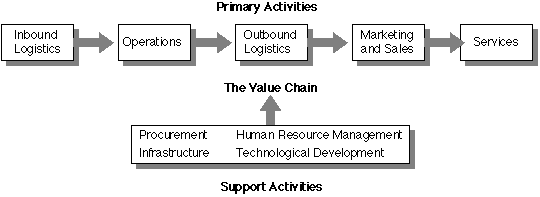Porter's Value Chain

The idea of the value chain is based on the process view of organisations, the idea of seeing a manufacturing (or service) organisation as a system, made up of subsystems each with inputs, transformation processes and outputs. Inputs, transformation processes, and outputs involve the acquisition and consumption of resources - money, labour, materials, equipment, buildings, land, administration and management. How value chain activities are carried out determines costs and affects profits.
Most organisations engage in hundreds, even thousands, of activities in the process of converting inputs to outputs. These activities can be classified generally as either primary or support activities that all businesses must undertake in some form.
According to Porter (1985), the primary activities are:
- Inbound Logistics - involve relationships with suppliers and include all the activities required to receive, store, and disseminate inputs.
- Operations - are all the activities required to transform inputs into outputs (products and services).
- Outbound Logistics - include all the activities required to collect, store, and distribute the output.
- Marketing and Sales - activities inform buyers about products and services, induce buyers to purchase them, and facilitate their purchase.
- Service - includes all the activities required to keep the product or service working effectively for the buyer after it is sold and delivered.
Secondary activities are:
- Procurement - is the acquisition of inputs, or resources, for the firm.
- Human Resource management - consists of all activities involved in recruiting, hiring, training, developing, compensating and (if necessary) dismissing or laying off personnel.
- Technological Development - pertains to the equipment, hardware, software, procedures and technical knowledge brought to bear in the firm's transformation of inputs into outputs.
- Infrastructure - serves the company's needs and ties its various parts together, it consists of functions or departments such as accounting, legal, finance, planning, public affairs, government relations, quality assurance and general management.









